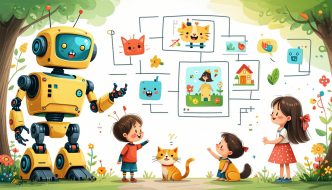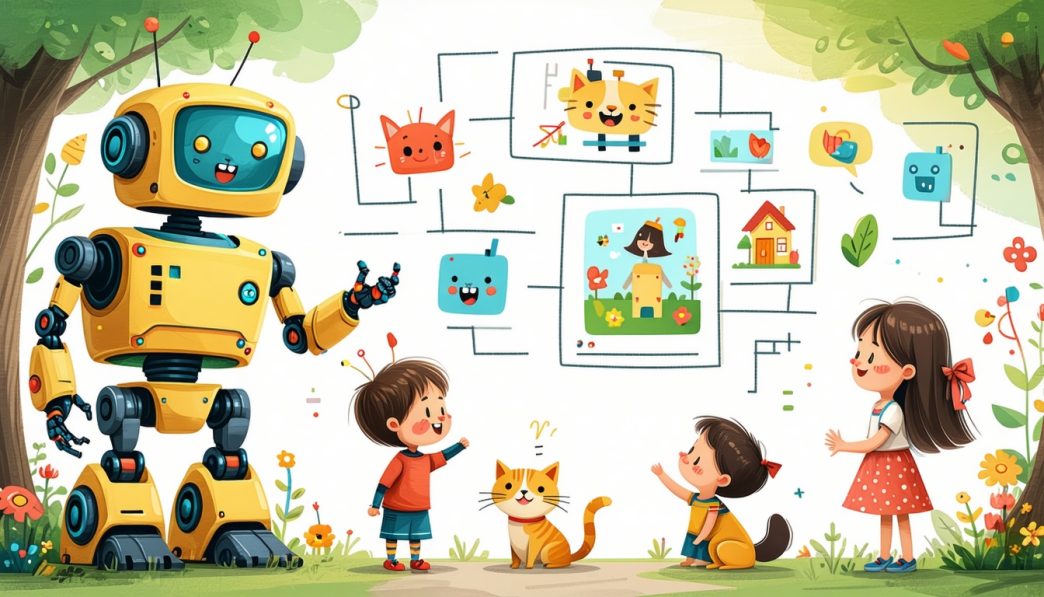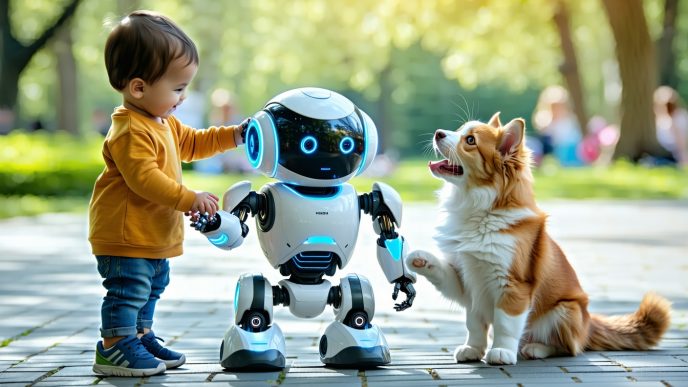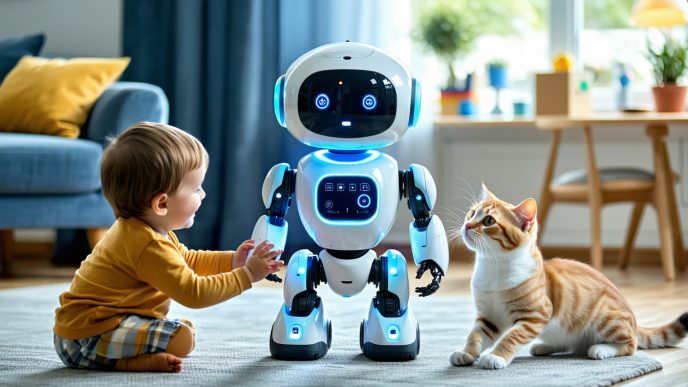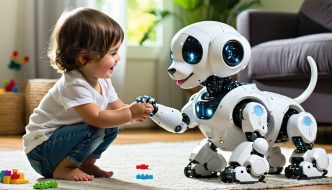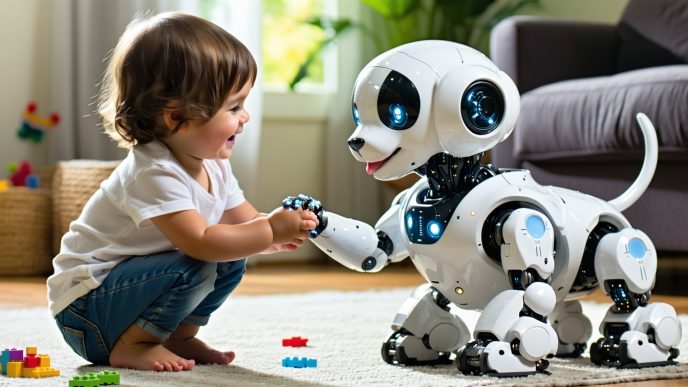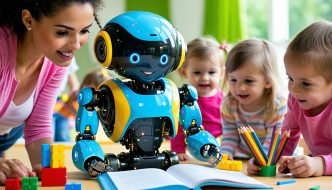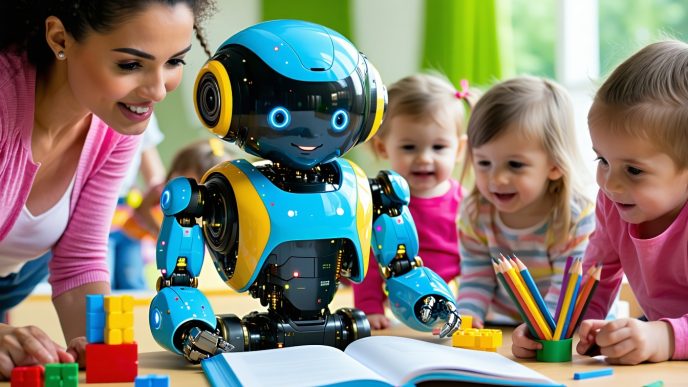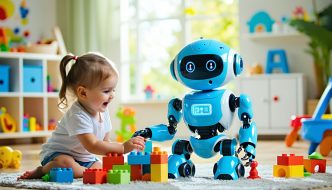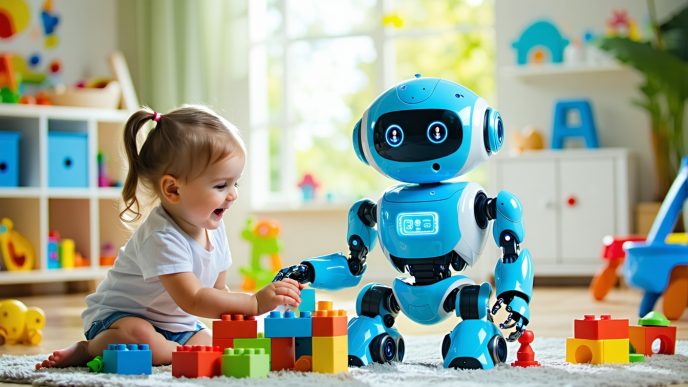Introduction to Robot-Assisted Learning
Robot-assisted learning is becoming an innovative approach for teaching young children crucial skills, particularly around boundaries and rules. By integrating robotics into the learning environment, parents and educators can effectively convey important lessons about safety and appropriate behaviors.
The Role of Robots in Teaching Boundaries and Rules
Robots serve as engaging tools for teaching children about personal space and social boundaries. They can model behaviors and provide real-life scenarios that are relatable and easy for kids to understand. This interaction often leads to a more effective learning experience compared to traditional teaching methods.
Through interactive sessions, robots can help children identify safe and unsafe behaviors. They can demonstrate what is acceptable behavior when interacting with others, including pets, helping to reinforce the importance of rules.
| Learning Aspect | Example Robot Activity | Benefit |
|---|---|---|
| Personal Space | Robot encourages children to maintain a safe distance during play | Teaches physical boundaries |
| Obeying Commands | Robots act only when given specific commands | Reinforces the importance of following rules |
| Social Interaction | Robots simulate real-life social settings | Encourages understanding of appropriate behavior |
Benefits of Using Robots for Child and Pet Interaction
Using robots to facilitate interactions between children and pets can yield multiple benefits. Notably, these robotic systems help teach children how to interact safely with animals, promoting both empathy and responsibility.
Robots can simulate pet behavior, allowing children to practice how to approach and engage with pets in a controlled setting. This leads to a better understanding of animal boundaries, which is essential for safe interactions.
| Interaction Type | Activity | Benefit |
|---|---|---|
| Child and Robot | Robot mimics pet behaviors | Helps children learn appropriate touch and approach techniques |
| Child and Pet | Robot interacts with pet in a supervision role | Teaches safe play and respect for animal boundaries |
Additionally, as children interact with robots, they can develop emotional connections, which can further facilitate their understanding of relationships and care. For more insights into the emotional aspects of these interactions, visit our article on emotional bonding with robots.
The integration of robots in teaching boundaries and rules enhances not just learning but also prepares children for managing real-life interactions with both their peers and pets. Understanding the dynamics of such relationships through the lens of robotics helps forge a safer and more nurturing environment for kids. For more information on how to use robots effectively for child and pet interaction, explore our additional resources.
Teaching Children About Boundaries
Robots can play a significant role in teaching children about boundaries and appropriate behavior, helping to create a safer environment for kids and pets alike. This section will explore various strategies that robots can employ to educate children regarding safety, interaction, and expectations.
Establishing Safe Interaction Zones
One effective method for teaching children about boundaries is the establishment of safe interaction zones. Robots can be programmed to define specific areas where children can interact with pets or engage in activities. These zones help create a clear understanding of where safe play occurs and where caution is necessary.
| Interaction Zone | Description |
|---|---|
| Play Area | A designated space for energetic play with robots or pets. |
| Quiet Zone | An area for reading or calming activities, away from distractions. |
| Eating Zone | A designated place for meals, teaching children to respect personal space during snack or meal times. |
Robots can use sensors to monitor these zones, providing gentle reminders and cues to children when they stray outside the defined areas. This promotes awareness and helps children learn the importance of respecting personal boundaries.
Reinforcing Rules and Expectations
Another critical aspect of teaching boundaries is reinforcing rules and expectations. Robots can act as interactive companions that consistently deliver messages regarding appropriate behavior. Through games and activities, they can instill positive messages about treating pets with kindness and following household rules.
For example, a robot might engage a child in a game emphasizing the importance of not jumping on furniture or making too much noise around pets. This repetition enables children to internalize rules in a fun and engaging manner.
| Rule | Explanation |
|---|---|
| No Rough Play | Encourages gentle interaction with pets. |
| Quiet Voices | Reinforces the need for calmness around animals. |
| Sharing Space | Teaches the importance of taking turns in shared areas. |
Utilizing robots as tools for reinforcement creates a consistent learning environment while also providing a smooth flow of information regarding household norms and expectations. For more insights on how robots can assist with child and pet interaction, additional resources are available.
Encouraging Positive Behavior
Robots can also play a vital role in encouraging positive behavior in children. By providing immediate feedback, robots can help reinforce good choices and actions. This immediate reinforcement, which can include praise or rewards, boosts children’s confidence and motivates them to continue engaging in positive interactions.
| Positive Behavior | Robot Response |
|---|---|
| Gentle Touch | Robot might respond with encouragement or a cheerful tone. |
| Following Rules | Immediate praise from the robot to affirm their behavior. |
| Sharing with Pets | Acknowledgment or playful rewards from the robot. |
Through games, storytelling, and other engaging activities, robots can integrate lessons about empathy, respect, and kindness. This positive reinforcement creates a nurturing environment where children learn the benefits of good behavior in a playful and enjoyable manner.
For further exploration of how robots can serve as educational tools and companions, check out our articles on robots as play companions for children and robot activity tracking for pets and kids.
Robot-Assisted Learning Activities
Robots are increasingly becoming integral tools in teaching children about boundaries and rules. They engage kids through various interactive activities that promote learning and development in a safe environment.
Interactive Games and Simulations
Interactive games designed for robot-assisted learning allow children to grasp concepts of safety and boundaries while having fun. These games often involve challenges that require kids to think critically and respond appropriately to different scenarios.
| Game Type | Key Concept | Learning Outcome |
|---|---|---|
| Virtual Safety Scenarios | Establishing personal space | Understanding safe distances |
| Problem-Solving Challenges | Recognizing danger signs | Quick thinking in emergencies |
| Cooperative Tasks | Teamwork and communication | Sharing and respecting others’ space |
The integration of gameplay not only makes learning enjoyable but also reinforces essential safety lessons. This method encourages children to think about their actions and the impact they have on others.
Role-Playing Scenarios
Role-playing scenarios provide children with practical experiences where they can practice adhering to rules and boundaries. These activities involve children taking on different roles, allowing them to explore various situations in a controlled environment.
| Role | Scenario | Focus Area |
|---|---|---|
| Parent | Managing playtime with friends | Setting limits and rules |
| Teacher | Guiding classroom behavior | Respecting authority and peers |
| First Responder | Responding to emergencies | Assessing situations for safety |
Such scenarios are valuable for teaching children about appropriate interactions and behaviors, fostering empathy, and enhancing social skills. By simulating real-life situations, kids learn the importance of boundaries in their relationships with others.
Real-Time Feedback and Monitoring
Robots equipped with real-time feedback capabilities can monitor children’s interactions and behavior instantly. This feature enables them to provide immediate and constructive feedback, guiding children towards safer behaviors.
| Feedback Type | Benefits | Implementation |
|---|---|---|
| Visual Cues | Immediate understanding of wrong actions | Color-coded alerts during activities |
| Audio Prompts | Reinforcement of positive behavior | Encouraging words when rules are followed |
| Data Tracking | Insight into behavior patterns | Daily reviews with parents for reinforcement |
By monitoring progress and providing feedback, robots help children internalize safety rules while also keeping parents informed. This interaction supports not just learning, but also emotional bonding, as children feel recognized and guided through their experiences. For more on how robots can support child and pet engagement, explore our article on child and pet interaction with robots.
Implementing these robot-assisted learning activities creates an engaging and safe environment for children to learn and practice important life skills.
Implementing Safety Measures
As robots become integral to teaching children about boundaries and rules, it’s crucial to prioritize safety in their design and use. Implementing specific safety measures can help ensure a secure environment for both kids and pets during their interactions with these technological companions.
Secure Robot Design Features
When designing robots for educational purposes, certain features should be included to promote safety. Below are some essential secure design characteristics that should be considered:
| Feature | Description |
|---|---|
| Impact Resistance | Robots should be built with materials that can withstand bumps and drops, reducing the risk of injury. |
| Soft Edges | Designs should avoid sharp edges to prevent any cuts or scratches during play. |
| Stable Base | Robots should have a low center of gravity to prevent tipping, ensuring that they remain upright during interactions. |
| Emergency Shutdown | An accessible shut-off switch or voice command can allow quick deactivation in case of unexpected behavior. |
Parental Controls and Supervision
To enhance the safety of robot-assisted learning, robust parental controls are vital. These controls can help parents manage the robot’s functions and track their child’s interactions. Effective measures include:
- Configurable Interaction Levels: Parents can set the robot’s interaction intensity based on the child’s age and developmental stage.
- Activity Monitoring: Options for viewing reports on what activities the child engaged in with the robot can be provided.
- Supervision Alerts: Notifications can be sent to parents if the robot detects unsafe behavior or interactions, giving them the opportunity to intervene.
By utilizing these parental controls, families can ensure a safer learning environment. For more information on how robots can monitor and interact with children and pets, visit our article on robots monitoring pets at home.
Privacy and Data Protection Guidelines
Data privacy is a crucial aspect when implementing robots that teach children about safety. Families should be aware of the following guidelines to protect their personal information:
| Guideline | Description |
|---|---|
| Data Encryption | Any data collected by the robot should be encrypted to prevent unauthorized access. |
| Minimized Data Collection | Robots should only gather data necessary for their functioning, minimizing the risk of exposure. |
| User Consent | Parents should provide consent before data collection begins, ensuring they are informed about what data is being collected. |
| Regular Updates | Keeping the robot’s software updated can help patch vulnerabilities and enhance data security. |
Following these guidelines can help safeguard personal information while allowing children to learn effectively through robot interactions. For additional insights on ensuring a safe experience, explore our article on safety features for kids and pets in robots.
These safety measures allow families to embrace robot-assisted learning confidently, knowing that both their children and pets are secure in the process.
Monitoring and Tracking Progress
Integrating robots into the learning process enables effective tracking and monitoring of children’s progress in understanding boundaries and rules. This not only helps in assessing their learning milestones but also enhances their overall interaction with robots, pets, and their environment.
Tracking Learning Milestones
Robots can be programmed to observe and record children’s behavior in various scenarios, allowing for the measurement of learning milestones. This capability provides parents with insight into their child’s progress regarding interactions and understanding of rules.
| Milestone | Description | Indicators |
|---|---|---|
| Initial Awareness | Child recognizes the concept of boundaries | Verbal acknowledgment of rules |
| Engagement in Learning | Active participation in robot-assisted activities | Increased interaction frequency |
| Application of Rules | Child applies learned rules in real scenarios | Demonstrated understanding during play |
Utilizing data from these milestones, parents can better understand how effectively robots are assisting in teaching safety to kids, which can be further explored in articles like robots monitoring pets at home.
Analyzing Behavioral Patterns
In addition to tracking milestones, robots can analyze behavioral patterns during interactions. By collecting data on how children respond to various scenarios, robots can provide analytics to help parents identify areas where reinforcement may be needed.
| Behavior Type | Interpretation | Actionable Insight |
|---|---|---|
| Positive Reinforcement | Child follows rules consistently | Continue with similar activities |
| Resistance or Non-Compliance | Child struggles to follow rules | Adjust teaching strategies |
| Curiosity or Experimentation | Child explores boundaries | Encourage exploration with guidance |
These insights can also contribute to improving emotional bonding, as parents can observe changes in interactions with robots as discussed in emotional bonding with robots.
Adjusting Teaching Strategies
To maximize the effectiveness of robot-assisted learning, teaching strategies can be adjusted based on tracked data and analyzed patterns. This dynamic approach allows for tailored interactions that meet the child’s unique learning pace and style.
| Adjustment Strategy | Purpose | Potential Outcomes |
|---|---|---|
| Customized Activity Difficulty | To match the child’s skill level | Enhanced engagement and learning |
| Varied Interaction Techniques | Introduce diverse methods to maintain interest | Broader understanding of concepts |
| Increased Feedback Frequency | Offer immediate corrections and encouragement | Reinforcement of rules and boundaries |
These customized approaches enhance the educational experience, making robots invaluable partners in teaching children. The advancements in this field can be further explored in discussions surrounding future of robot interactions with children and pets.
By actively monitoring and adapting to children’s needs, robots can effectively teach safety to kids while fostering a positive learning environment. For further information on child and pet dynamics, visit our section on child and pet interaction with robots.
Future Trends and Considerations
As technology progresses, the role of robots in teaching safety and proper interaction to children and pets is evolving. This section examines advancements in robot technology, ethical and social implications, and the integration of robots in education and childcare.
Advancements in Robot Technology
Recent innovations have led to the development of more sophisticated robots that better cater to the needs of children and pets. These advancements include enhanced artificial intelligence capabilities, improved sensory perception, and dynamic interaction techniques. Current trends indicate a focus on user-friendly interfaces, allowing for seamless integration into daily life.
| Advancement | Description |
|---|---|
| AI Development | Robots are now equipped with algorithms that enable them to learn from interactions and adapt their teaching methods. |
| Sensory Technology | Robots can now detect emotions and behaviors, providing tailored feedback for enhanced learning experiences. |
| Interactive Design | Improved mobility and voice recognition make interactions more engaging for children and pets. |
Ethical and Social Implications
The use of robots to teach children about safety and boundaries raises various ethical and social questions. Parents and educators must consider the balance between technology and human interaction. While robots can provide crucial learning opportunities, there is also concern regarding the potential decrease in face-to-face communication skills.
Moreover, the emotional bond formed between children and robots is an important topic. Research indicates that interactions with robots can contribute to emotional learning, yet it is crucial to ensure that these robots do not replace real-life relationships. For further insights, explore our article on emotional bonding with robots.
Integration of Robots in Education and Childcare
The integration of robots in educational settings and childcare is becoming increasingly common. Many institutions are beginning to incorporate robots as teaching aids and play companions. This fosters a unique learning environment where children can explore concepts of safety and cooperation.
| Integration Area | Description |
|---|---|
| Early Education | Robots serve as interactive tools that introduce safety concepts at an age-appropriate level. |
| Social Skills Development | Group activities with robots can enhance teamwork and communication skills among children. |
| Home Learning | Families utilize robots for safety monitoring, allowing children to learn boundaries in a controlled setting. For insights into robots monitoring pets, visit robots monitoring pets at home. |
As robots continue to evolve and their applications expand, understanding the implications of these technologies will be essential for fostering a safe and engaging learning environment for children and pets. For more on these future trends, check out our article on future of robot interactions with children and pets.

